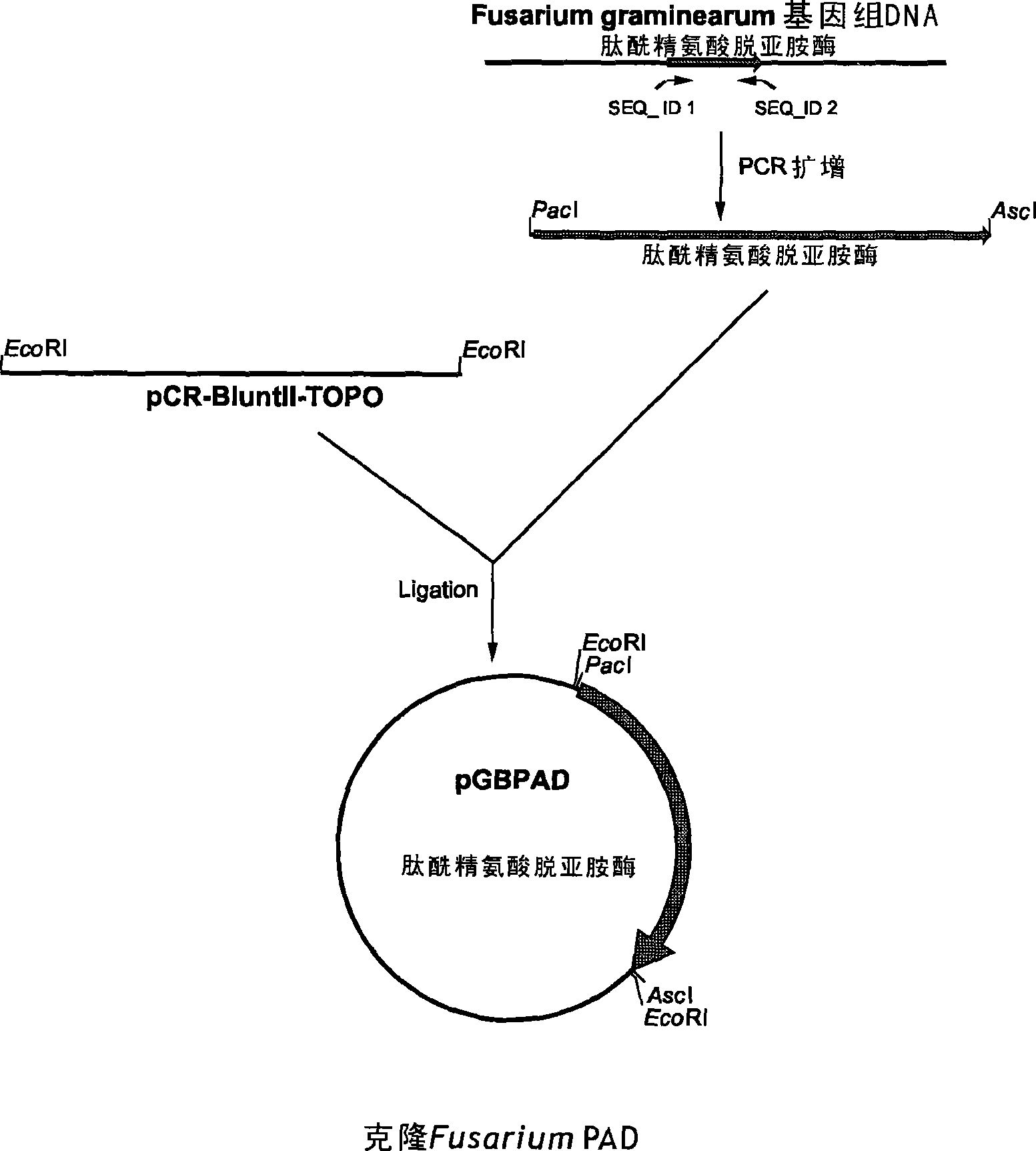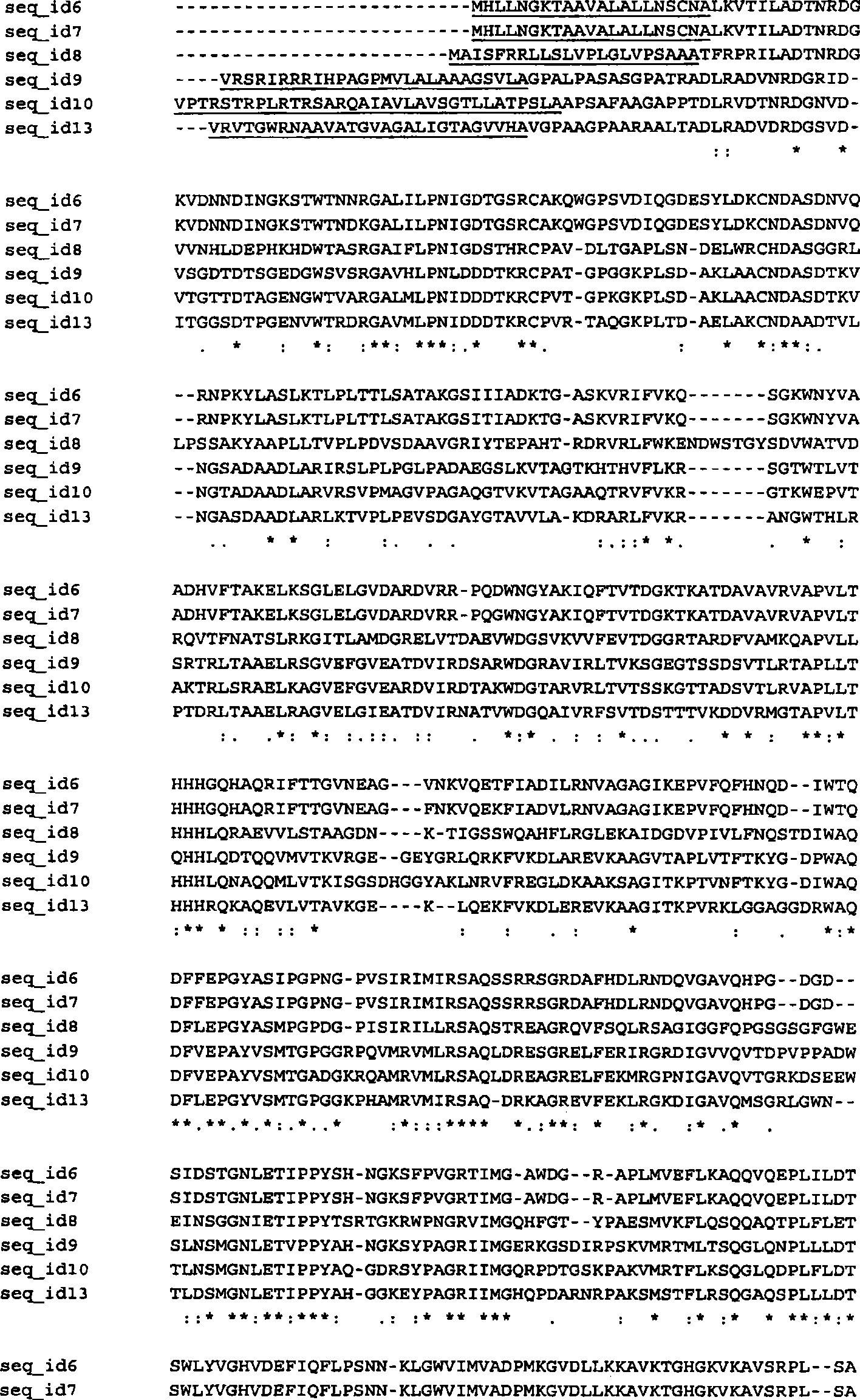Peptidylarginine deiminase and uses thereof in the production of citrullinated proteins and peptides
A technology of arginine deiminase and citrulline, applied in the field of proteins and peptides, which can solve problems such as serious and taste problems
- Summary
- Abstract
- Description
- Claims
- Application Information
AI Technical Summary
Problems solved by technology
Method used
Image
Examples
Embodiment 1
[0202] Example 1 Fusarium strain can secrete PAD-like activity
[0203] A large collection of molds was screened to identify secreted PAD-like activity. For this purpose, the strains were pre-cultured on Potato Dextrose Broth (PDB; Difco) at 30°C for 4-5 days. Then, the culture was harvested by centrifugation, washed with distilled water, and transferred to minimal medium enriched with rice protein hydrolyzate. Rice protein is relatively rich in arginine residues, and to increase its water solubility, rice protein (Remy Industries, Leuven, Belgium) was preincubated with Alcalase (NOVO, Bagsvaerd, Denmark) at pH 7.5 to obtain a DH of ca. The hydrolyzate of 15. The minimal medium used contained 0.52 g KCl, 1.52 g KH per liter 2 PO 4 , 1.3ml 4M KOH, 0.52g MgSO 4· 7H 2 O, 22mg ZnSO 4· 7H 2 O, 11 mg H 3 BO 3 , 5mg FeSO 4· 7H 2 O, 1.7mg CoCl 2· 6H 2 O, 1.6mgCuSO 4· 5H 2 O, 5mg MnCl 2· 4H 2 O, 1.5 mg Na 2 MoO 4· 2HO, 50mg EDTA, 40g glucose and 5g hydrolyzed rice...
Embodiment 2
[0204] Example 2 Identification of the PAD-encoding gene in the Fusarium genome sequence
[0205] Now that some Fusarium strains are known to secrete PAD-like activity, the genomic sequences of the genes encoding these PADs were isolated and analyzed. For this purpose, Fusarium graminearum strains CBS166.57, CBS316.73, CBS11063, CBS18432 and CBS792.70 were cultured in PDB (Potato Dextrose Medium, Difco) at 30 °C for 3 days and grown according to the supplier's Chromosomal DNA was isolated using the Q-Biogene kit (Cat. No. 6540-600; Omnilabo International BV, Breda, the Netherlands) according to the instructions. This chromosomal DNA was used to amplify the coding sequence of the PAD gene using PCR.
[0206]Two PCR primers were designed to specifically amplify the PAD gene from chromosomal DNA of Fusarium graminearum strains CBS166.57, CBS316.73, CBS11063, CBS18432 and CBS792.70. The primer sequence was obtained in part from a sequence found in the genomic DNA of Gibberella...
Embodiment 3
[0214] Example 3 Overexpression of possible Fusarium graminearum PAD by Aspergillus niger
[0215] From the pGBPAD plasmid containing the genomic PAD gene from Fusarium graminearum CBS166.57, the PacI / AscI fragment containing the PAD coding sequence was isolated and exchanged with the PacI / AscI phyA fragment in pGBFIN-5 (WO 99 / 32617). The resulting plasmid is a PAD expression vector called pGBFINPAD (see image 3 ). The expression vector pGBFINPAD was linearized by digestion with NotI, which removed all E. coli derived sequences from the expression vector. Digested DNA was purified using phenol:chloroform:isoamyl alcohol (24:23:1 ) extraction and ethanol precipitation. These vectors were used to transform Aspergillus niger CBS513.88. The Aspergillusniger transformation procedure is extensively described in WO 98 / 46772. It also describes how to select for transformants on agar plates containing acetamide and how to select for targeted multi-copy integrants. Preferably, A...
PUM
| Property | Measurement | Unit |
|---|---|---|
| molecular weight | aaaaa | aaaaa |
Abstract
Description
Claims
Application Information
 Login to View More
Login to View More - R&D
- Intellectual Property
- Life Sciences
- Materials
- Tech Scout
- Unparalleled Data Quality
- Higher Quality Content
- 60% Fewer Hallucinations
Browse by: Latest US Patents, China's latest patents, Technical Efficacy Thesaurus, Application Domain, Technology Topic, Popular Technical Reports.
© 2025 PatSnap. All rights reserved.Legal|Privacy policy|Modern Slavery Act Transparency Statement|Sitemap|About US| Contact US: help@patsnap.com



